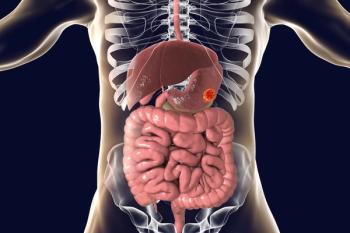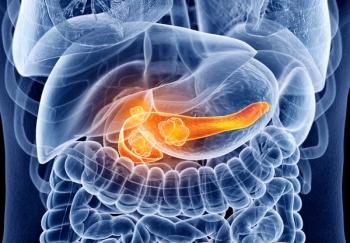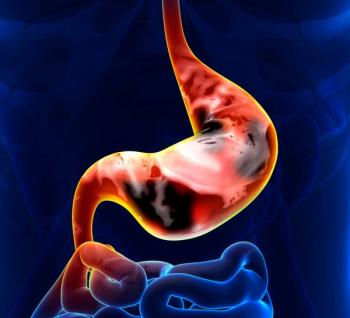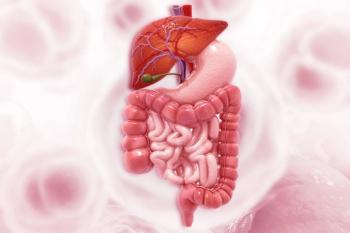
- ONCOLOGY Vol 11 No 9
- Volume 11
- Issue 9
Oral UFT Plus Leucovorin in Patients With Relapsed or Refractory Colorectal Cancer
Therapeutic options for patients with advanced colorectal cancer who have failed treatment with fluorouracil (5-FU) are limited. Responses have been reported in this setting with a protracted venous infusion of 5-FU. Daily oral therapy with tegafur and uracil (UFT) plus leucovorin (LV) has the potential to mimic the pharmacology of continuous infusion 5-FU. Therefore, we undertook a phase II study of a 28-day schedule of a combination chemotherapy regimen containing oral UFT/leucovorin in patients with measurable metastatic colorectal cancer who had failed treatment with bolus 5-FU. In addition, we sought to determine whether coadministration of UFT and leucovorin alters the bioavailability of these agents. In a pretreatment phase, each patient underwent sequential pharmacokinetic sampling following a single dose of UFT alone, leucovorin alone, and the combination of UFT plus leucovorin. The preliminary results of this trial suggest that tegafur pharmacokinetics are not affected by coadministration of leucovorin and that folate pharmacokinetics are not affected by UFT. [ONCOLOGY 11(Suppl 10):22-25, 1997]
ABSTRACT: Therapeutic options for patients with advanced colorectal cancer who have failed treatment with fluorouracil (5-FU) are limited. Responses have been reported in this setting with a protracted venous infusion of 5-FU. Daily oral therapy with tegafur and uracil (UFT) plus leucovorin (LV) has the potential to mimic the pharmacology of continuous infusion 5-FU. Therefore, we undertook a phase II study of a 28-day schedule of a combination chemotherapy regimen containing oral UFT/leucovorin in patients with measurable metastatic colorectal cancer who had failed treatment with bolus 5-FU. In addition, we sought to determine whether coadministration of UFT and leucovorin alters the bioavailability of these agents. In a pretreatment phase, each patient underwent sequential pharmacokinetic sampling following a single dose of UFT alone, leucovorin alone, and the combination of UFT plus leucovorin. The preliminary results of this trial suggest that tegafur pharmacokinetics are not affected by coadministration of leucovorin and that folate pharmacokinetics are not affected by UFT. [ONCOLOGY 11(Suppl 10):22-25, 1997]
Tegafur and uracil (UFT) is composed of a 1:4 fixed molar ratio of Ftorafur (tegafur) and uracil. Tegafur is a fluorouracil (5-FU) prodrug, and uracil competes with 5-FU as a substrate for dihydropyrimidine dehydrogenase, an enzyme responsible for 5-FU catabolism. UFT may be administered orally with excellent gastrointestinal absorption, and therefore is potentially attractive as an alternative to 5-FU. When UFT was administered orally with the biochemical modulator leucovorin in a 28-consecutive-day schedule, response rates of 25% to 43% were observed in patients with previously untreated advanced colorectal cancer.[1,2]
Patients with colorectal cancer who fail initial 5-FU-based therapy have limited therapeutic options. The camptothecin derivative irinotecan has shown a response rate of 15% to 25% in this setting.[3-5] A protracted venous infusion of 5-FU has also been reported to overcome resistance in a small subset of patients previously treated with bolus 5-FU. [6,7] Given the potential of daily oral UFT/leucovorin to mimic the pharmacology of a protracted venous infusion of 5-FU, we undertook a phase II trial of this therapy in patients with advanced colorectal cancer who had failed bolus 5-FU therapy.
In addition, this study addresses the pharmacological questions of whether coadministration of leucovorin affects UFT bioavailability and whether UFT affects leucovorin bioavailability, as such interactions could affect clinical efficacy. A third study objective is to determine the toxicity of this regimen in a previously treated patient population. In this article, we present preliminary pharmacological data from this ongoing clinical trial.
Patients eligible for this trial have histologically confirmed unresectable colorectal adenocarcinoma that is either metastatic or locally advanced and bidimensionally measurable. Patients must be at least 18 years old, with Eastern Cooperative Oncology Group performance status 0 to 2 (ambulatory at least 50% of the time), and a life expectancy of at least 12 weeks. Patients must also have either failed previous therapy with bolus 5-FU plus leucovorin for advanced disease, or relapsed within 6 months of completion of 5-FU-based adjuvant therapy. Study participation also requires an absolute neutrophil count ³ 1,500/µL, platelet count ³ 100,000µL, bilirubin 1.5 mg/dL, and serum creatinine £ 1.5 mg/dL. Previous therapy with UFT or infusional 5-FU is not permitted. The Institutional Review Board at Roswell Park Cancer Institute approved this protocol. Written informed consent is required from all subjects.
Treatment Program
Patients are treated with UFT 300 mg/m²/day plus leucovorin 90 mg/day in 3 divided doses every 8 hours for 28 consecutive days, followed by a 1-week rest period (1 cycle = 35 days). UFT is prepared as 100 mg (tegafur) capsules, and total daily dosage is rounded to the nearest 100 mg. If the number of daily capsules cannot be evenly divided among the three daily administration times, the greater number of capsules are taken in the morning and afternoon, and the least number in the evening. Two 15-mg oral leucovorin tablets are taken with each UFT dose. UFT/leucovorin is taken on an empty stomach (at least 1 hour before or 2 hours after food), with 8 oz of fluid.
If grade 3 to 4 hematologic toxicity occurs during a cycle, treatment is withheld, but is resumed following recovery at the same dose level to complete a 28-day treatment course. In subsequent cycles, however, the UFT dose is reduced to 250 mg/m²;/day. For grade 2 to 4 nonhematologic toxicity during a cycle, treatment is withheld until resolution, then reinstituted at full dose for grade 2, or at UFT 250 mg/m²/day for grade 3 to 4 toxicity. For grade 0 to 2 nonhematologic toxicity, no dose modification is required for subsequent cycles; for grade 3 and 4 nonhematologic toxicity, the UFT dose is reduced to 250 mg/m²/day and 200 mg/m²/day, respectively, in the subsequent cycle.
Disease evaluations are repeated every two cycles and treatment is continued until disease progression is documented or it is no longer in the patients best interest to continue.
Pharmacokinetic Sampling
The 18 patients enrolled in part 1 will be evaluated for UFT and leucovorin pharmacokinetics. A three-treatment by three-period crossover bioavailability comparison of oral leucovorin 30 mg plus UFT 200 mg vs either leucovorin or UFT alone is scheduled for the 8 days preceding the first cycle of chemotherapy. Each patient is being randomized to one of six schedules, as shown in Table 1.
Plasma samples are obtained at 0, 15, 30, 60, 90, 120, 180, 300, and 480 minutes after drug administration for measurement of tegafur, 5-FU, uracil, leucovorin, and 5-methyltetrahydrofolate (5-MTHF). Blood samples are centrifuged for 15 minutes at 1,000g at approximately 5°C; plasma is then separated and stored at -20°C until analysis. Due to the instability of 5-MTHF in plasma samples, an antioxidant (5 mg ascorbic acid) is added to blood samples used to determine 5-MTHF concentrations prior to centrifugation.
Plasma concentrations of tegafur, leucovorin, and 5-MTHF are determined by high-pressure liquid chromatography. Plasma concentrations of 5-FU and uracil are determined by a gas chromatography/mass spectroscopy assay with a lower limit of quantitation for 5-FU of 0.5 ng/mL.
Plasma disposition of the five analytes of UFT/leucovorin therapy (tegafur, 5-FU, uracil, leucovorin, and 5-MTHF) are summarized by calculating the area under the concentration-time curve (AUC) from 0 to 8 hours, using standard noncompartmental methods.[8]
Statistical Analyses
This phase II study has a two-stage design. Eighteen patients will be enrolled in the first stage. If 0 to only 1 of the 18 patients participating in stage 1 of this study achieve a complete or partial response, the study will be closed to further accrual and the treatment concluded to be inactive (reject Ha: response rate ³ 20%). If 2 to 3 patients achieve a complete or partial response in stage 1, a total of 33 patients will be enrolled (15 patients in stage 2). If four or more of the first 18 patients respond to therapy, the study will be terminated with a conclusion of significant activity (reject H0: response rate £ 5%).
At the end of stage 2, at least five responses are required to reject H0; otherwise Ha will be rejected, with the conclusion that this regimen is not of significant clinical utility in this context. With this design, and using Flemings one-sided multiple testing procedure,[9] the probability of erroneously concluding that this therapy is effective (rejection H0) is 2.5% (type I error), and the probability of erroneously concluding that the therapy is ineffective (rejecting Ha) is 20.6% (type II error).
With 18 subjects undergoing pharmacokinetic sampling, the power to establish bioequivalence for tegafur between UFT alone and UFT/leucovorin is over 99%.[10] This power calculation is based on previous estimates of intersubject coefficient of variation of 20% for tegafur Cmax and 18% for tegafur AUC following a single dose of UFT 300 mg (D. H. Ho,PhD, personal communication, 1996). It assumes a 60% intrasubject correlation and similar variation between the single agent and combination treatments.
The power to conclude bioequivalence is 77% for d,l-leucovorin between leucovorin alone and concurrent leucovorin/UFT assuming an intrapatient correlation of 60% and similar variation between the single-agent and combination treatments. This calculation is based on a previously reported intersubject coefficient of variation of 46.8% for l-leucovorin AUC following administration of 25-mg leucovorin tablets.[11] Comparisons of pharmacokinetic parameters were made using a paired t-test.
As of May 1997, 18 patients with colorectal cancer, including 12 men and 6 women, have undergone pharmacological sampling. The median age of participating patients is 62 years (range, 37 to 80 years). Fifteen of the patients had liver metastases. Response and toxicity outcomes will be reported at the completion of the trial, but preliminary pharmacokinetic data are available now for tegafur, leucovorin, and 5-MTHF: Table 2 compares tegafur pharmacokinetics when UFT is administered alone or with leucovorin. Figure 1 shows tegafur plasma concentrations over time. In this analysis, leucovorin appears to have no significant impact on tegafur bioavailability or pharmacokinetics. Table 3 shows leucovorin and 5-MTHF plasma pharmacokinetics when 30 mg of leucovorin is administered either alone or with 200 mg of UFT. Plasma levels of leucovorin and 5-MTHF over time are shown in Figure 2. These preliminary data suggest that the bioavailability and pharmacokinetics of leucovorin are not affected by concurrent administration of UFT.
Phase II studies have shown that oral UFT/leucovorin is an active and well-tolerated regimen in patients with previously untreated colorectal cancer.[1,2] A prior pharmacokinetic analysis has suggested that 5-FU plasma levels with oral UFT/leucovorin are similar to those obtained with protracted venous infusions of 5-FU.[12]
There is a paucity of effective second-line therapies for the treatment of advanced colorectal cancer. It has been reported that some patients who fail bolus 5-FU therapy respond to continuous 5-FU infusions. Therefore, we undertook the current study to determine the response rates and toxicity of daily oral UFT/leucovorin in patients who have shown 5-FU resistance. In addition, the potential impact of concurrent administration of leucovorin on UFT bioavailability and pharmacokinetics, as well as the impact of UFT on leucovorin bioavailability and pharmacokinetics, has not been studied previously. We included these measurements in the current phase II study because identification of a bioavailability interaction could have important implications for dose and schedule recommendations.
The pharmacokinetic data presented suggest that concurrent administration does not impact on the gastrointestinal absorption or plasma pharmacokinetics of either UFT (tegafur and uracil) or leucovorin. Analysis of 5-FU pharmacokinetics is in progress, and will determine whether the plasma levels of 5-FU obtained with this regimen are sufficient for antitumor activity, as was suggested in our previous report.[1]
The data presented demonstrate that coadministration with leucovorin does not alter the pharmacology of tegafur derived from orally administered UFT. In addition, preliminary data from 14 patients suggest that folate pharmacology is not affected by UFT. Analysis of 5-FU and uracil pharmacokinetics is under way. Final response and toxicity data will indicate whether further study of this regimen is warranted in colorectal cancer patients who have shown resistance to bolus 5-FU.
References:
1. Meropol NJ, Rustum YM, Petrelli NJ, et al: A phase I and pharmacokinetic study of oral uracil, Ftorafur, and leucovorin in patients with advanced cancer. Cancer Chemother Pharmacol 37:581-586, 1996.
2. Pazdur R, Lassere Y, Rhodes V, et al: Phase II trial of uracil and tegafur plus oral leucovorin: An effective oral regimen in the treatment of metastatic colorectal carcinoma. J Clin Oncol 12:2296-2300, 1994.
3. Shimada Y, Yoshino M, Wakui A, et al: Phase II study of CPT-11, a new camptothecin derivative, in metastatic colorectal cancer. J Clin Oncol 11:909-913, 1993.
4. Rothenberg ML, Eckardt JR, Kuhn JG, et al: Phase II trial of irinotecan in patients with progressive or rapidly recurrent colorectal cancer. J Clin Oncol 14:1128-1135, 1996.
5. von Hoff DD, Rothenberg ML, Pitot HC, et al: Irinotecan (CPT-11) therapy for patients with previously treated metastatic colorectal cancer (CRC): Overall results of FDA-reviewed pivotal US clinical trials (abstract 803). Proc Am Soc Clin Oncol 16:228a, 1997.
6. Mori A, Bertoglio S, Guglielmi A, et al: Activity of continuous-infusion 5-fluorouracil in patients with advanced colorectal cancer clinically resistant to bolus 5-fluorouracil. Cancer Chemother Pharmacol 33:179-180, 1993.
7. Tralongo P, Di Mari A, Scibilia G, et al: Prolonged 5-fluorouracil infusion in patients with metastatic colon cancer pretreated with bolus schedule of the same agent. Anticancer Res 15:635-638, 1995.
8. Noncompartmental analysis based on statistical moment theory, in Gibaldi M, Perrier D (eds): Pharmacokinetics, pp 409-416. New York, Marcel Dekker, 1982.
9. Fleming TR: One-sided multiple testing procedures for phase II clinical trials. Biometrics 38:143-151, 1982.
10. Diletti E, Hauschke D, Steinijans VW: Sample size determination for bioequivalence assessment by means of confidence interval. Int J Clin Pharmacol Ther Toxicol 29:1-8, 1991.
11. Straw JA, Szapary D, Wynn WT: Pharmacokinetics of the diastereoisomers of leucovorin after intravenous and oral administration to normal subjects. Cancer Res 44:3114-3119, 1984.
12. Pazdur R, Covington WP, Brown NS, et al: Comparative steady state pharmacokinetics of oral UFT versus protracted intravenous 5-fluorouracil (FU) (abstract #1498). Proc Am Soc Clin Oncol 15:474, 1996.
Articles in this issue
over 28 years ago
UFT: East Meets West in Drug Developmentover 28 years ago
Rationale for Phase I Study of UFT Plus Leucovorin and Oral JM-216over 28 years ago
Postoperative Adjuvant Chemotherapy for Non-Small-Cell Lung Cancerover 28 years ago
UFT in Gastric Cancer: Current Status and Future Developmentsover 28 years ago
Oral UFT and Leucovorin in Patients With Advanced Gastric Carcinomaover 28 years ago
Experience With UFT in JapanNewsletter
Stay up to date on recent advances in the multidisciplinary approach to cancer.

















































































